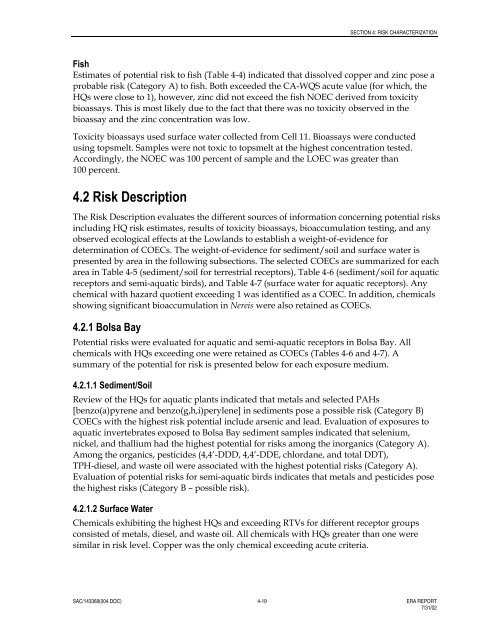1.1 MB pdf - Bolsa Chica Lowlands Restoration Project
1.1 MB pdf - Bolsa Chica Lowlands Restoration Project
1.1 MB pdf - Bolsa Chica Lowlands Restoration Project
Create successful ePaper yourself
Turn your PDF publications into a flip-book with our unique Google optimized e-Paper software.
SECTION 4: RISK CHARACTERIZATION<br />
Fish<br />
Estimates of potential risk to fish (Table 4-4) indicated that dissolved copper and zinc pose a<br />
probable risk (Category A) to fish. Both exceeded the CA-WQS acute value (for which, the<br />
HQs were close to 1), however, zinc did not exceed the fish NOEC derived from toxicity<br />
bioassays. This is most likely due to the fact that there was no toxicity observed in the<br />
bioassay and the zinc concentration was low.<br />
Toxicity bioassays used surface water collected from Cell 11. Bioassays were conducted<br />
using topsmelt. Samples were not toxic to topsmelt at the highest concentration tested.<br />
Accordingly, the NOEC was 100 percent of sample and the LOEC was greater than<br />
100 percent.<br />
4.2 Risk Description<br />
The Risk Description evaluates the different sources of information concerning potential risks<br />
including HQ risk estimates, results of toxicity bioassays, bioaccumulation testing, and any<br />
observed ecological effects at the <strong>Lowlands</strong> to establish a weight-of-evidence for<br />
determination of COECs. The weight-of-evidence for sediment/soil and surface water is<br />
presented by area in the following subsections. The selected COECs are summarized for each<br />
area in Table 4-5 (sediment/soil for terrestrial receptors), Table 4-6 (sediment/soil for aquatic<br />
receptors and semi-aquatic birds), and Table 4-7 (surface water for aquatic receptors). Any<br />
chemical with hazard quotient exceeding 1 was identified as a COEC. In addition, chemicals<br />
showing significant bioaccumulation in Nereis were also retained as COECs.<br />
4.2.1 <strong>Bolsa</strong> Bay<br />
Potential risks were evaluated for aquatic and semi-aquatic receptors in <strong>Bolsa</strong> Bay. All<br />
chemicals with HQs exceeding one were retained as COECs (Tables 4-6 and 4-7). A<br />
summary of the potential for risk is presented below for each exposure medium.<br />
4.2.<strong>1.1</strong> Sediment/Soil<br />
Review of the HQs for aquatic plants indicated that metals and selected PAHs<br />
[benzo(a)pyrene and benzo(g,h,i)perylene] in sediments pose a possible risk (Category B)<br />
COECs with the highest risk potential include arsenic and lead. Evaluation of exposures to<br />
aquatic invertebrates exposed to <strong>Bolsa</strong> Bay sediment samples indicated that selenium,<br />
nickel, and thallium had the highest potential for risks among the inorganics (Category A).<br />
Among the organics, pesticides (4,4’-DDD, 4,4’-DDE, chlordane, and total DDT),<br />
TPH-diesel, and waste oil were associated with the highest potential risks (Category A).<br />
Evaluation of potential risks for semi-aquatic birds indicates that metals and pesticides pose<br />
the highest risks (Category B – possible risk).<br />
4.2.1.2 Surface Water<br />
Chemicals exhibiting the highest HQs and exceeding RTVs for different receptor groups<br />
consisted of metals, diesel, and waste oil. All chemicals with HQs greater than one were<br />
similar in risk level. Copper was the only chemical exceeding acute criteria.<br />
SAC/143368(004.DOC) 4-19 ERA REPORT<br />
7/31/02






